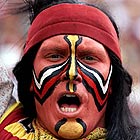 Correspondent Melvin Martin writes:
Correspondent Melvin Martin writes:I am critically aware that way too much has already been analyzed, re-analyzed, written, and re-written by scores of well-meaning academicians and dedicated activists on the subject of Indian mascots, and I am now deeply compelled to describe my own beliefs as to why this particular issue continues to linger on ad nauseam.
Until recently, I have never really given much thought to the Indian mascot controversy before as I have always found competitive sports (aside from boxing and martial arts) to be very
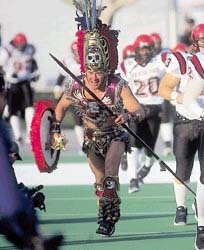 uninteresting. However, I have come to believe that American sports institutions have embraced Indian imagery largely because Indians are--in the collective consciousness of modern non-Indian America--something to be greatly feared. To Euro-Americans, the Indian is the original example of "shock and awe."
uninteresting. However, I have come to believe that American sports institutions have embraced Indian imagery largely because Indians are--in the collective consciousness of modern non-Indian America--something to be greatly feared. To Euro-Americans, the Indian is the original example of "shock and awe."Sports teams seek any edge they can get. Striking fear into the hearts of opponents, even to a small degree, is psychologically and strategically valuable. Hence the psychodramas before and during the game: the wild dances, the spear chucks, the tomahawk chops. At some level they're meant to intimidate or disconcert the enemy.
Indians as predatory animals
 From my relatively new perspective, Indian sports mascots are eerily akin to the colorful paintings of tiger and shark teeth (and even flames) that have appeared on various combat aircraft, naval vessels, and other forms of mechanized equipment since World War II. They are all starkly produced images designed to strike a deep sense of fear into the hearts and minds of enemy forces.
From my relatively new perspective, Indian sports mascots are eerily akin to the colorful paintings of tiger and shark teeth (and even flames) that have appeared on various combat aircraft, naval vessels, and other forms of mechanized equipment since World War II. They are all starkly produced images designed to strike a deep sense of fear into the hearts and minds of enemy forces.The white man has always feared Indians as the most singularly hostile and fearsome opponents on the battlefields of yesteryear. Non-Indians still consider Indians worthy antagonists on a wide range of fronts--not only cultural but political and
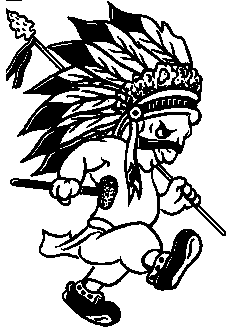 socioeconomic fronts as well. What better method of psychological warfare to employ in the rarefied realm of athletic competition than historically rich symbols with the power to frighten one's adversaries?
socioeconomic fronts as well. What better method of psychological warfare to employ in the rarefied realm of athletic competition than historically rich symbols with the power to frighten one's adversaries?The psychodynamics of fear are clearly at work here. One easily observes this phenomenon in the natural world with (primarily) predatory animals imbued with bright colors; huge mouths of dagger-like teeth; large, penetrating eyes and powerful physiques or the ability to pump themselves up to towering heights over other predators. Discounting the sillier kinds of Indian mascots (of which there are not really many), most mascots are fearfully rendered in terms of form and color to resemble the myriad beasts of prey. Facial war paint in the color of blood red, anyone?
SWMs seek manhood
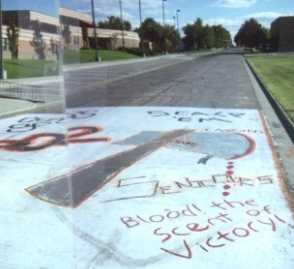 I can now see why sports mascots are so highly valued by those individuals and institutions who are so unwilling to relinquish them (despite decades of highly organized opposition to them). It is the basic symbology of the American Indian as a unique and profound source of fear that provides these people with their sense of “warrior-hood” and masculinity. In a world where even perceived notions of strength and power (and most importantly, the ability to kill) still prevail, associating oneself with warlike Indians provides a security blanket of support. If a man can't act like a "savage" in reality, at least he can pretend to be one.
I can now see why sports mascots are so highly valued by those individuals and institutions who are so unwilling to relinquish them (despite decades of highly organized opposition to them). It is the basic symbology of the American Indian as a unique and profound source of fear that provides these people with their sense of “warrior-hood” and masculinity. In a world where even perceived notions of strength and power (and most importantly, the ability to kill) still prevail, associating oneself with warlike Indians provides a security blanket of support. If a man can't act like a "savage" in reality, at least he can pretend to be one.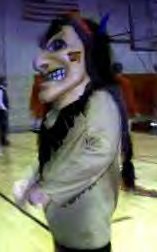 In today’s popular American culture, traditional ideals of masculinity are under a constant state of attack. Gays, women, and minorities are (seen to be) advancing and gaining parity at all levels of society. In this environment, the all-American (essentially white) male is indeed a threatened species. And perhaps one of the last remaining bastions of this male superiority is the world of contact sports, where a man can still “be a man” in spite of the gay team member, the female trainer, or the minority head coach.
In today’s popular American culture, traditional ideals of masculinity are under a constant state of attack. Gays, women, and minorities are (seen to be) advancing and gaining parity at all levels of society. In this environment, the all-American (essentially white) male is indeed a threatened species. And perhaps one of the last remaining bastions of this male superiority is the world of contact sports, where a man can still “be a man” in spite of the gay team member, the female trainer, or the minority head coach.The Indian sports mascot is not so much an example of honoring the so-called “character” of the American Indian. Rather, it is a process of co-opting the impressive cachet of overwhelming fear that the Indian, in the collective mindset of white America, still possesses to a remarkable degree.
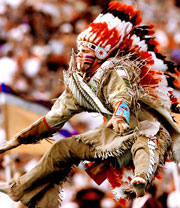 Comment: Martin's point is similar to the point made by David P. Rider in "Indians" and Animals: A Comparative Essay. As Rider put it:
Comment: Martin's point is similar to the point made by David P. Rider in "Indians" and Animals: A Comparative Essay. As Rider put it:
2 comments:
"The white man has always feared Indians as the most singularly hostile and fearsome opponents on the battlefields of yesteryear. Non-Indians still consider Indians worthy antagonists on a wide range of fronts--not only cultural but political socioeconomic fronts as well. What better method of psychological warfare to employ in the rarefied realm of athletic competition than historically rich symbols with the power to frighten one's adversaries?"
As an Indian man who grew up playing sports such as football, basketball and baseball all the way through high school I have never found the Indian mascot image offensive. Even when we played teams like the "Chiefs" or the "Seminoles". Perhaps I am so secure in my own unique heritage to really care. Do you think Sam Bradford would turn down a $100 million dollar contract offered by the Washington Redskins for example? People who have spoken out on the tired and irrelevant mascot issue are primarily non-Indian "do-gooders" trying to make name for themselves, like the countless anthropologists and "Native" historians before them, to sell a book or obtain academic recognition.
Professional sports and collegiate athletics choose to fly the Native mascot image because it empowers them to associate themselves with some of the most fearsome natural warriors in history. The plains Indians for example. Even the military honors the warrior spirit of Indians by naming their awesome weapons of war names like: The Tomahawk cruise missile, the Blackhawk and Apache attack helicopters, there was even a battleship that was attacked on Dec,7th 1941 at Pearl Harbor named the Oglala.
Whites honor us Indians, they want to be Indian, they want to go into battle with Indians or at least the image or name of a tribe on their jerseys. American Indians are synonymous with valor and bravery and reckless abandon who charged into battle prepared to die. Dying in battle was what "warriorhood" was all about. Today's modern warrior does not preoccupy himself with trivial matters like mascots. Leave that for the faux Native activists, the "weekend warrior", for the lack of a better term.
Today's' modern warrior concerns himself with how to feed his children or prevent his nephew from joining a gang or helping a sister addicted to crystal meth get sober. The Native mascot issue is important, however, it can be put on the backburner for now. We need to address social issues that threaten the survival of our people: Teen pregnancy, teen suicide, substance abuse, domestic violence and Third World conditions on the rez. Once we have conquered all of these issues then we can contemplate the stupidity of some white boy running around a football field in a comical monkey suit or other Indian costume.
J. Kills Straight
Lakota, Sioux
You're either secure or apathetic about your heritage. I don't know which. ;-)
Yes, I understand athletes want to associate themselves with savage, warlike Indians who look and act like predatory animals. That's Melvin's and my point, not yours.
Smart multitaskers can deal with mascots and other pressing issues at the same time. Besides, some Indians consider stereotypes the worst Native problem.
I and others have addressed many of your claims in Team Names and Mascots, The Harm of Native Stereotyping: Facts and Evidence, Indians in the Military, and Indians as Warriors. Read 'em and learn.
Post a Comment